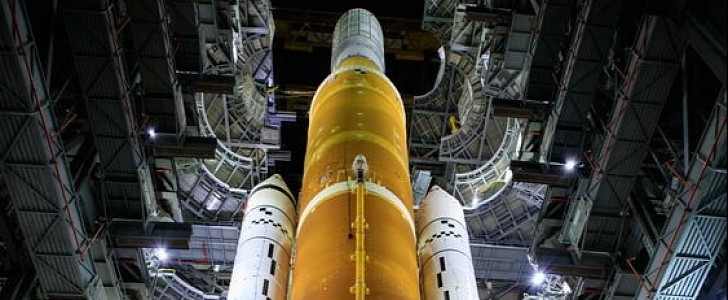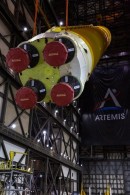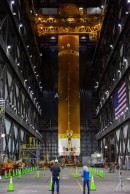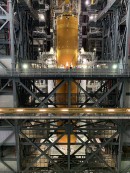NASA has awarded Northrop Grumman a $3.19 billion contract to produce boosters for the agency's Space Launch System (SLS) mega rocket. The award includes production for boosters that will support the next six SLS flights for Artemis IV through Artemis VIII crewed missions to the Moon.
NASA's SLS is a launch vehicle designed to pave the way for human exploration beyond Earth's orbit. It's a massive beast that is capable of sending humans, cargo, and the Orion spacecraft to the Moon on a single trip.
The final configuration will stand 322 feet (98 meters) tall. For reference, that's bigger than the Statue of Liberty. To get off the ground, it'll need some powerful boosters. Each SLS launch will be powered by the twin solid rocket boosters positioned on the side of the rocket's core stage, which will generate more than 75 percent of the thrust.
The company's design for the key components is built on decades of experience supporting NASA programs. So far, it has produced booster motors for the first three Artemis missions and is currently casting motors for the fourth lunar mission. As part of the contract, Northrop Grumman will design upgraded boosters needed for flights starting with the ninth SLS mission (Artemix IX) - this will increase their performance and allow them to support a higher payload volume.
"Upgrading the booster's performance ensures we can improve SLS's ability to send astronauts and cargo to the Moon as well as making our processes more efficient," explained Bruce Tiller, SLS Booster Manager at NASA's Marshall Space Flight Center.
The SLS rocket is part of NASA's Artemis program, which plans to land the first woman and the next man on the lunar surface by the middle of the decade. The rocket will also be used for establishing infrastructure on and around the Moon and will prepare humanity for its next stop: Mars.
The final configuration will stand 322 feet (98 meters) tall. For reference, that's bigger than the Statue of Liberty. To get off the ground, it'll need some powerful boosters. Each SLS launch will be powered by the twin solid rocket boosters positioned on the side of the rocket's core stage, which will generate more than 75 percent of the thrust.
The company's design for the key components is built on decades of experience supporting NASA programs. So far, it has produced booster motors for the first three Artemis missions and is currently casting motors for the fourth lunar mission. As part of the contract, Northrop Grumman will design upgraded boosters needed for flights starting with the ninth SLS mission (Artemix IX) - this will increase their performance and allow them to support a higher payload volume.
"Upgrading the booster's performance ensures we can improve SLS's ability to send astronauts and cargo to the Moon as well as making our processes more efficient," explained Bruce Tiller, SLS Booster Manager at NASA's Marshall Space Flight Center.
The SLS rocket is part of NASA's Artemis program, which plans to land the first woman and the next man on the lunar surface by the middle of the decade. The rocket will also be used for establishing infrastructure on and around the Moon and will prepare humanity for its next stop: Mars.







